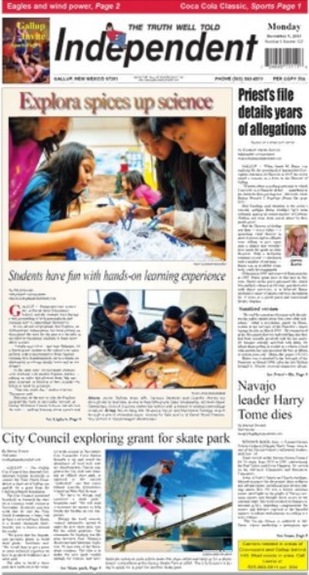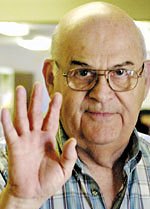|
Priest's file details years of allegations By Elizabeth Hardin-Burrola [See the first article in this series: Disastrous Legacy of Abuse: Gallup Priest's Personnel File Released, by Elizabeth Hardin-Burrola, Gallup Independent, December 7, 2013.] GALLUP — When James M. Burns was studying for the priesthood at Immaculate Conception Seminary in Missouri in 1959, his rector raised a concern in a letter to the Diocese of Gallup. “Whereas there is nothing precisely to which I can refer as a character defect … something in his character does not ring true,” the rector wrote Bishop Bernard T. Espelage (Burns file, page 552). Had Espelage paid attention to the rector’s concern, perhaps Burns wouldn’t have been ordained, sparing an untold number of Catholic children and teens from sexual abuse by their parish priest. But the Diocese of Gallup was then — as it is today — a sprawling, rural diocese in need of priests and its officials were willing to give some men a chance that wouldn’t have made the grade in other dioceses. With a lackluster seminary record — checkered with a number of red flags — Burns was an available warm body, ready for assignment. Ordained in 1962 and removed from ministry in 1993, Burns spent most of that time in Arizona. Based on his priest personnel file, which was publicly released in October, and interviews with abuse survivors, it is believed Burns molested a series of adolescent boys throughout his 31 years as a parish priest and correctional facility chaplain. Sanitized version “He said the sexual involvement with the adolescent males started about four years after ordination,” stated a psychiatric report on Burns, written at the Servants of the Paraclete’s Jemez Springs facility in March 1990. “He remembered in his first parish that two kids told him that they had been sexually involved with the last priest. He became sexually involved with them. He talked about getting in trouble in a reform school with another boy and described the boy as fifteen or sixteen years old.” (Burns file, pages 234-235) Burns was evaluated by the Servants of the Paraclete in March 1990, after the late Bishop Donald E. Pelotte received numerous allegations of embezzlement and sexual misconduct leveled against Burns at St. Joseph’s Parish in Winslow, Ariz. Burns was subsequently admitted to the facility’s Villa Louis Martin program in May 1990. In their reports, the Paraclete staffers seemed to accept Burns’ sanitized version that he had been “sexually involved” with adolescent boys as if that were not criminal behavior. The file contains no evidence staffers ever challenged Burns’ claims the incidents were far in the past or challenged his outlandish assertions that the boys had sometimes instigated the “involvement.” The file also contains no expressed concern by the Paracletes or Pelotte for the physical, emotional or spiritual welfare of Burns’ victims (Burns file, pages 213-220, 234-235). Instead, like the Rev. Peter Lechner, director of Villa Louis Martin, they praised Burns for facing his issues “in his direct, honest, ‘no nonsense’ way” (Burns file, page 275).
Within six months, Pelotte was recycling Burns back into the diocese in a new parish in Blanco, N.M. During Burns’ discharge meeting on Nov. 6, 1990, Lechner urged Burns to immediately begin seeing a therapist “in the event that other accusations should surface, or that the criticism of this assignment by other priests should present a problem” (Burns file, pages 301-304). Disturbing story In the spring of 1993, Burns’ life as a priest imploded when another allegation was made against him — this time by an adult woman who came forward with a disturbing story that Burns and another priest had ritually abused her as a child. Brother Duane Torisky, then the chancellor, typed up a detailed summary of the allegation, which had been reported by the Rev. Tim Farrell. The woman was a member of Farrell’s parish, and had once even met Pelotte and Torisky by picking them up at an airport (Burns file, pages 335-336). Burns’ file is packed with documents about the woman, including correspondence with her numerous therapists, pages of handwritten notes speculating about the credibility of her story and the state of her mental health, worries about Navajo County criminal investigators, and fears about the story becoming public. Burns’ defense was pedophile-worthy: “Jim claims he never had sex with anyone else but boys — never women,” stated a handwritten note in the file from April 2, 1993. To the contrary, Burns had told the Servants of the Paraclete he had been with a woman once, but he found the experience frightening, just like he found women (Burns file, pages 215, 234, 380). Early retirement In the midst of the crisis, Lechner helped Pelotte ease Burns out of ministry by writing a letter that reversed his previous endorsement of Burns as a pastor. Pelotte wrote the alleged victim that Burns was taking an early retirement effective June 15, 1993, “primarily prompted by his present health situation,” but added the “resignation is not to be interpreted as an admission of guilt” (Burns file, pages 366, 390). Whether or not the woman’s allegation was credible, it managed to finally push Burns out of ministry. Burns retired to Wickenburg, Ariz., but did not stop causing headaches for the Gallup chancery. Several years later, Burns had to be reprimanded after diocesan officials learned he had been celebrating Mass in the Diocese of Phoenix and apparently presenting himself as a monsignor (Burns file, pages 433-440). Eventual prosecution After another gap in time, Burns’ file jumps to the spring of 2002, when the clergy sex abuse crisis spread from the Boston Archdiocese to parishes across the country. The Gallup Diocese received letters from the Arizona Attorney General’s Office, the Apache County Attorney, and the Diocese of Tucson regarding the allegations of a man who said Burns sexually assaulted him in a drive-in movie theater in 1974 (Burns file, pages 445-454, 457-476). After Deacon Timoteo Lujan and the Rev. Larry O’Keefe had phone conversations with the man, there are no more references to him in the file. In addition, Arizona law enforcement officials never filed criminal charges against Burns in the matter (Burns file, pages 456, 482-483). Editor’s Note: On Tuesday, the Independent will look at another file released with the Archdiocese of Los Angeles records that details the actions of a religious order priest who recently worked in the Diocese of Gallup.
|
.
Any original material on these pages is copyright © BishopAccountability.org 2004. Reproduce freely with attribution.

